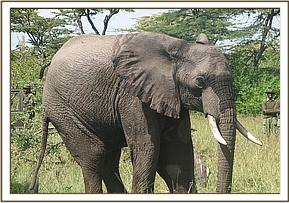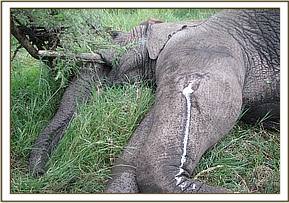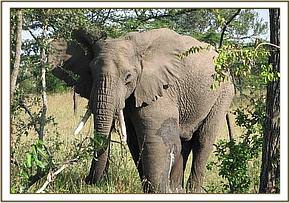A report was received last month by the Mara Mobile Veterinary Unit from the management of Naboisho Conservancy, which borders the world famous Masai Mara National Reserve of a young bull elephant seen limping slightly on the front left leg
A report was received last month by the Mara Mobile Veterinary Unit from the management of Naboisho Conservancy, which borders the world famous Masai Mara National Reserve of a young bull elephant seen limping slightly on the front left leg.
The veterinary unit was quick to respond, gathering everything needed to attend to this clinical case. On arrival, the team found the young elephant bull (which they approximated to be around fifteen years old) browsing under some Acacia scrubland. On closer inspection it was soon noticed that there was a small wound just below the shoulder blade. From a distance the injury looked small and not life-threatening.
Further diagnosis was done when the elephant was darted with an anaesthetizing drug, and upon closer examination it was clear that the young bull had been targeted by a sharp object, most probably an arrow or a spear. All possible medication was administered and the elephant was revived before he quickly got back onto his feet and wandered away into the bush.




Another seven days went by and the bull sadly had to be treated yet again. Visually the wound looked better but astonishingly the elephant could hardly put any weight on the injured leg. This left the team wondering why since the wound looked dry and was healing. Not giving up the team continued to investigate the state of this poor elephant and decided to use a metal detector on the wound, which eventually beeped indicating a foreign metallic object deep within the bulls muscles. Trying to remove the object would have meant severing muscles and probably even severing nerves which would have been fatal to the elephant.
During the bulls last few days, the team came to conclusion that a lethal Acokanthera-laced arrowhead must be lodged within the elephants leg, which was slowly killing him, and no matter the intervention employed the team had no hope of saving this suffering bull. Heartbreakingly yet inevitably a few days later the elephant died despite all of the teams ongoing efforts to save his life.
The natural and easily extracted Acokanthera poison is said to be potent enough to kill an elephant in a matter of minutes if fresh and well prepared, whilst being incredibly difficult to treat or detect through conventional means, which is why such a brutal age-old method of poaching is still used today and is still killing hundreds of Kenyas majestic elephants.
The Mara Mobile Veterinary Unit would like to thank the KWS, the DSWT, the Minara Foundation and all of the units sponsors and partners who have made our work possible in the African bush to save our wild kin.
By Felix Micheni- Mara Mobile Field Veterinary Officer
To help support the David Sheldrick Wildlife Trust's mobile veterinary units in working together with the Kenyan Wildlife Service in protecting and keeping these Emperors of Tsavo safe please donate through this link: https://www.sheldrickwildlifetrust.org/is/donate_now.asp